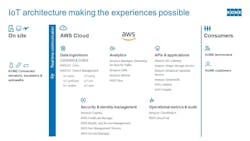Case Study: Advanced IoT and AI solidify KONE’s elevator and escalator predictive maintenance services
Key Highlights
-
KONE’s AWS-powered IoT platform boosts predictive maintenance with real-time insights and scalability.
-
Generative AI tools like Technician Assistant cut downtime and improve field service efficiency.
-
Advanced IoT analytics helped KONE achieve 70% more fault detection and 40% fewer equipment issues.
-
A scalable, cloud-based data foundation enables continuous innovation and smarter urban mobility.
KONE is a leader and innovator in the building technology industry. The global provider of elevators, escalators, moving walkways, and automatic doors has a mission to improve the flow of urban life. Founded in 1910, the Finland-based company now operates in more than 60 countries and moves an astonishing two billion people every day.
In addition to new building solutions, KONE provides maintenance and modernization services for its elevators and escalators as well as third-party products. “We have 40,000 technicians making over 100,000 visits to our customers every day, serving all different kinds of equipment,” says Amy Chen, SVP and chief innovation officer at KONE.
Long a proponent of preventive maintenance, KONE quickly grasped the potential of intelligent predictive maintenance technologies for identifying equipment issues before they become a problem. The company’s initial Internet of Things (IoT) platform for connecting its elevators and escalators for predictive maintenance was soon replaced with advanced IoT and related technologies from Amazon Web Services (AWS), which were more suited to KONE’s needs and business goals.
Its strategic partnership with AWS also led to co-innovation of a tool powered by generative AI (GenAI) that improves field service speed and effectiveness.
KONE’s experiences on its IoT and AI journey offer lessons for others seeking connectivity and optimization for their products and services—whether strengthening predictive maintenance with near-real-time insights, seamlessly scaling fleet operations, or enabling greater design flexibility and innovation.
Building a data-driven maintenance framework: How KONE modernized equipment performance monitoring
KONE needed a clearer window into equipment performance to help predict and prevent disruptions, accelerate repairs, increase passenger safety, and further improve people flow. IoT-enabled machine condition sensors and advanced analytics were among the targeted technologies.
In 2016, the company developed KONE 24/7 Connected Services, an intelligent predictive maintenance offering originally built on a third-party IoT platform where sensors monitor critical machine parameters such as usage levels and speed, and advanced analytics identify equipment issues before they become a problem. Customers using this service have their connected equipment monitored around-the-clock by KONE experts.
The initial solution was effective though not ideal for KONE’s expanding operational goals, including connecting all 1.6 million pieces of equipment in its maintenance base. By 2020, KONE decided that a more-robust IoT and data analytics foundation was needed to connect a greater share of its equipment to the cloud, use the digitized data to streamline its operational processes, and create new value-added services for its customers.
Integrating IoT and generative AI with AWS to drive predictive maintenance and field service efficiency
KONE rebuilt the IoT platform using AWS cloud services, IoT, and AI to better support its growing fleet of smart devices with a scalable, secure, and highly available architecture.
- For cloud connectivity, AWS IoT Core provides the ability to “connect billions of IoT devices and route trillions of IoT messages” to AWS services and other devices without infrastructure management.
- AWS IoT Device Management allows KONE to register, organize, monitor, and remotely manage IoT devices at scale.
- IoT sensors ingest 3,000 events per second, sending data to the cloud where AI algorithms can quickly identify potential problems.
- KONE’s collected data is stored in Amazon Simple Storage Service (Amazon S3), providing the foundation for additional, tailorable analytics services and predictive maintenance.
- Customers using KONE’s 24/7 Connected Services with the new IoT backbone can remotely activate their equipment’s IoT sensor and securely connect it to the cloud (a process called provisioning), increasing visibility into their elevator operations and enabling KONE to better monitor and manage its entire fleet of connected offerings.
In 2025, KONE co-innovated with AWS in developing the Technician Assistant, its new GenAI-powered tool that helps field technicians fix elevators faster. Built using Anthropic Claude models on Amazon Bedrock, Technician Assistant improves field service for connected elevators and escalators by providing quick solutions to technicians based on the asset’s maintenance history, IoT data, and relevant documentation.
Scaling industrial IoT operations for reliability, cost savings, and sustainable performance
The advanced IoT and AI solutions are significantly reducing the time and effort to resolve outages, lowering maintenance costs, improving sustainability metrics, and increasing operational efficiency for KONE and its customers. The new architecture also facilitates seamless scaling of fleet operations and the creation of new, innovative products.
Realized benefits include:
- 70% increase in proactive fault identification
- 40% fewer customer-reported elevator and escalator issues (“callouts”)
- 40% fewer entrapments (e.g., elevator door fails to open with passengers inside)
- 99.9% provisioning success rate
- 5x increase in the scale of connected IoT devices
“We’ve had quality improvements, security improvements, and architectural improvements, and financially we can do so much more on AWS. And the best benefit is the transparency of cost through AWS,” observes Ashish Agrawal, chief information officer at KONE. For example, scaling from 100,000 to 500,000 devices using its old IoT architecture would have cost KONE approximately three times more and likely crashed before reaching the current scale, he says.
The future of smart maintenance: AI, digital twins, and the evolution of connected infrastructure
The robust, reliable, and scalable IoT and analytics platform is meeting each of KONE’s objectives. “The technology core we built on AWS is a backbone on which we can scale, innovate in the market, and differentiate ourselves in the best urban flow experience,” says Agrawal. “We want to make daily life simpler.”
KONE is now focused on its next phase of innovation and collaboration: expanding its use of AI and digital twin services in urban buildings using AWS IoT TwinMaker. The company already completed a digital twin proof of concept, modeling the flow of people at the main metro station in Helsinki to analyze how to avoid bottlenecks.
About the Author

Sheila Kennedy
CMRP
Sheila Kennedy, CMRP, is a professional freelance writer specializing in industrial and technical topics. She established Additive Communications in 2003 to serve software, technology, and service providers in industries such as manufacturing and utilities, and became a contributing editor and Technology Toolbox columnist for Plant Services in 2004. Prior to Additive Communications, she had 11 years of experience implementing industrial information systems. Kennedy earned her B.S. at Purdue University and her MBA at the University of Phoenix. She can be reached at [email protected] or www.linkedin.com/in/kennedysheila.

